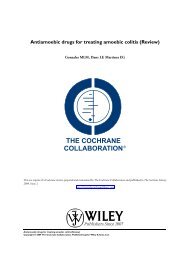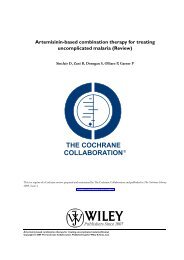Interventions for treating proximal humeral fractures in adults (Review)
Interventions for treating proximal humeral fractures in adults (Review)
Interventions for treating proximal humeral fractures in adults (Review)
Create successful ePaper yourself
Turn your PDF publications into a flip-book with our unique Google optimized e-Paper software.
• Immobilisation <strong>in</strong> sl<strong>in</strong>g and body bandage <strong>for</strong> one week<br />
versus three weeks: Kristiansen 1989 (85 participants).<br />
• Gilchrist bandage versus “classic” Desault bandage:<br />
Rommens 1993 (28 participants).<br />
(b) Cont<strong>in</strong>u<strong>in</strong>g management (rehabilitation) after <strong>in</strong>itial conservative<br />
treatment <strong>in</strong>volv<strong>in</strong>g sl<strong>in</strong>g immobilisation<br />
• Instructed self-physiotherapy versus conventional<br />
physiotherapy: Bertoft 1984 (20 participants); Lundberg 1979<br />
(42 participants).<br />
• Swimm<strong>in</strong>g pool treatment plus self-tra<strong>in</strong><strong>in</strong>g versus selftra<strong>in</strong><strong>in</strong>g<br />
alone: Revay 1992 (48 participants).<br />
• Apparatus supply<strong>in</strong>g pulsed electromagnetic field versus<br />
dummy apparatus: Livesley 1992 (48 participants).<br />
(2) Surgical treatment versus conservative treatment<br />
• Transcutaneous reduction and external fixation versus<br />
closed manipulation and sl<strong>in</strong>g: Kristiansen 1988 (30<br />
participants).<br />
• Internal fixation us<strong>in</strong>g surgical tension band or cerclage<br />
wir<strong>in</strong>g versus sl<strong>in</strong>g: Zyto 1997 (40 participants).<br />
• Hemi-arthroplasty versus closed manipulation and sl<strong>in</strong>g:<br />
Stable<strong>for</strong>th 1984 (32 participants).<br />
(3) Different methods of surgical management<br />
• Hemi-arthroplasty versus tension band wir<strong>in</strong>g: Hoellen<br />
1997 (30 participants); an additional n<strong>in</strong>e participants were<br />
reported <strong>in</strong> Holbe<strong>in</strong> 1999.<br />
(4) Cont<strong>in</strong>u<strong>in</strong>g management (<strong>in</strong>clud<strong>in</strong>g rehabilitation) after<br />
surgery<br />
• Immobilisation <strong>in</strong> sl<strong>in</strong>g <strong>for</strong> one week versus three weeks:<br />
Wirbel 1999 (77 participants).<br />
Studies await<strong>in</strong>g assessment<br />
<strong>Interventions</strong> <strong>for</strong> <strong>treat<strong>in</strong>g</strong> <strong>proximal</strong> <strong>humeral</strong> <strong>fractures</strong> <strong>in</strong> <strong>adults</strong> (<strong>Review</strong>)<br />
Copyright © 2008 The Cochrane Collaboration. Published by John Wiley & Sons, Ltd.<br />
Der Tavitian 2006: The registration details of this trial <strong>in</strong> the<br />
National Research Register are <strong>in</strong>complete, with no <strong>in</strong><strong>for</strong>mation<br />
on what <strong>in</strong>terventions are be<strong>in</strong>g compared. Further details have<br />
been requested.<br />
Lefevre-colau 2006: This trial is completed and has been submitted<br />
<strong>for</strong> publication.<br />
Parnes 2005: The abstract report of this study provides <strong>in</strong>sufficient<br />
details of the study methods and results. Further details have been<br />
requested.<br />
Pullen 2007: This apparently ongo<strong>in</strong>g trial is listed <strong>in</strong> the National<br />
Research Register (UK). Confirmation of its status and progress<br />
have been requested.<br />
Risk of bias <strong>in</strong> <strong>in</strong>cluded studies<br />
The quality of trial methodology based on trial reports was generally<br />
only moderate. While Livesley 1992 satisfied most of the<br />
quality criteria, it did not provide outcomes split by treatment<br />
group. The results <strong>for</strong> <strong>in</strong>dividual trials are presented below:<br />
Trial quality assessment table (Items 1-11 described <strong>in</strong> Table 1)<br />
1 2 3 4 5 6 7 8 9 10 11 Study<br />
3 1 1 1 0 0 3 1 3 1 3 Bertoft 1984<br />
1 0 0 0 0 0 1 1 3 1 3 Hoellen 1997<br />
3 3 1 3 0 0 3 1 3 3 3 Hodgson 2003<br />
1 1 0 3 0 0 3 1 3 1 3 Kristiansen 1988<br />
1 1 1 3 0 0 0 0 3 1 3 Kristiansen 1989<br />
3 1 3 3 3 3 3 3 3 1 1 Livesley 1992<br />
1 3 0 3 0 0 3 1 3 3 1 Lundberg 1979<br />
1 1 1 0 0 0 3 3 3 1 3 Revay 1992<br />
0 3 0 3 0 0 1 3 3 1 0 Rommens 1993<br />
1 1 0 1 0 0 1 1 1 1 1 Stable<strong>for</strong>th 1984<br />
1 0 0 3 0 0 3 3 1 1 1 Wirbel 1999<br />
1 0 0 3 0 0 1 3 3 3 3 Zyto 1997<br />
Allocation was clearly concealed (item 1) <strong>in</strong> only three trials (<br />
Bertoft 1984; Hodgson 2003; Livesley 1992). Two trials (Revay<br />
1992; Zyto 1997) used closed envelopes without report<strong>in</strong>g adequate<br />
safeguards. Aside from Rommens 1993, a quasi-randomised<br />
trial us<strong>in</strong>g alternation, the rema<strong>in</strong><strong>in</strong>g trials did not describe their<br />
method of randomisation.<br />
An <strong>in</strong>tention-to-treat analysis was possible <strong>in</strong> three trials (Hodgson<br />
2003; Lundberg 1979; Rommens 1993). Three trials scored zero<br />
<strong>for</strong> this item: Hoellen 1997, because of lack of <strong>in</strong><strong>for</strong>mation on the<br />
numbers of participants available at one and two year follow up<br />
by treatment group; Wirbel 1999, <strong>in</strong> part due to the unexpla<strong>in</strong>ed<br />
exclusion of participants from the analysis of Kirschner wire migration;<br />
and Zyto 1997, due to exclusion of three people who did<br />
not fulfil retrospectively imposed entry criteria.<br />
The outcome assessors were bl<strong>in</strong>d (item 3) <strong>in</strong> Livesley 1992.<br />
Though bl<strong>in</strong>d<strong>in</strong>g was reported <strong>in</strong> four other studies, three of these<br />
failed to record adequate safeguards (Bertoft 1984; Hodgson 2003;<br />
9








